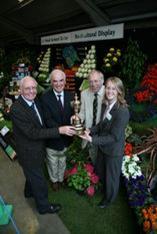
FPJ archives proved pivotal to the National Farmers’ Union (NFU) winning the Best in Show, Millennium Award (The Doncaster Cup) and Premier Exhibit Award at the Great Yorkshire Show earlier this month.
Former NFU horticulture board chairman Graham Ward worked with the NFU’s Mike Prest and his team to create the winning stand, pictured, in the flower and produce section of the show. The central theme used FPJ prices from 100 years ago to illustrate the relative value of home-grown fruit and vegetables to today’s consumers.
Taking prices from 1908 and comparing them with the 2008 levels, the NFU calculated that fresh produce is sold to the consumer at a quarter of the price of a century ago. Tomatoes sold in October 1908 for 52.5p a lb equated to an inflation-adjusted 13p a lb in 2008, and potatoes sold in January 1908 for 13.4p a lb were worth 3.7p a lb in 2008, using the same equation.
Ward, who scoured the annals for the comparative data, added: “The other outstanding fact is seasonality. Taking cucumbers, for example, prices ranging from £1.87 to 36p a head in 1908, when supply was available in differing volumes across the year, had changed to £2.40 to 10p in 1958, with no January supply. The Easter peak shows in both of these years.”
By 2008, the relative cucumber price was 33-35p, with no domestic supply in some months.
“The same applies in lettuce,” said Ward. “This is the effect of the supermarkets and, of course, better growing techniques and varieties. It takes part of the fun or risk out of growing when one grew for a high market and if you got it right, bingo, if you got it wrong, Carey Street.”
The most spectacular change was pineapple, which would have cost £15 a head in 1908, or a 10th of the average annual income. While that is the equivalent of 30p today, the pineapples in 1908 were from UK stove houses and, of course, only eaten by the very rich.
“We had a lot of interest in our exhibit, which was based around this information,” said Ward. “We talked to lots of showgoers about it, and the audience was basically rural, but not all farmers by any means.”
All produce for the stand was donated by Yorkshire growers. “It is always a topic of conversation,” said Ward, who heard comments such as “you don’t grow that here” or “I didn’t think you grew that in Yorkshire”



